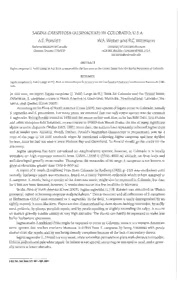
SAGINA CAESPITOSA (ALSINACEAE) IN COLORADO, U.S.A PDF
Preview SAGINA CAESPITOSA (ALSINACEAE) IN COLORADO, U.S.A
COLORADO, SAGINA CAESPITOSA (ALSINACEAE) IN U.S.A. WA Weber and Wittmann Porsildt A.E. R.C. Museum Museum Canada National of University of Colorado CANADA UCB USA. Ottawa, Ontario, 265, Boulder, Colorado 80309, edu weber@colorado. bill. we In this note, report Sagina caespitosa Vahl) Lange in HJ. Rink for Colorado and the United States. (J. Nu- North America Newfoundland, Otherwise, occurs in in Greenland, Manitoba, Labrador, caespitosa S. and Quebec (Crow navut, 2005). According to the Flora of North America (Crow 2005), two species of Sagina occur in Colorado, namely many we common saginoides and procumbens. For years, assumed that our only native species was the 5. S. saginoides. Erling Porsild visited in 1950 and the senior author took him, as he has Eilif Dahl, Eric Hulten S. Mount many and European on other botanists, excursions 14000-foot Evans, the of significant field to site (Weber have alpine or arctic disjuncts 1965, 1991). Since then, the authors repeatedly collected Sagina there Wendy me and at similar Recently, Dathan, Porsild's biographer (manuscript in preparation), sent a sites. how copy of the page in his field notebook where he mentioned collecting Sagina caespitosa and thrilled Hudson he was, since he had not seen since Bay and Greenland. To Porsild should go the credit for the it discovery. Sagina caespitosa has been considered an Amphiatlantic species; however, in Colorado locally is it abundant on high mountain summits from 12000-13500 (3700-4100 m) on and altitude, frost boils ft known well-developed gravelly moss tundra. Throughout the remainder of range, caespitosa not to its S. is grow than 1500 elevations greater (450 m). at ft A (Lindblom) from Colorado by Rydberg was overlooked report of Fries (1906, 130) until nivalis S. p. recently. Rydberg's report was erroneous, based on a Harry Patterson collection which here assigned to is being species of the American might also be expected in Colorado, but thus caespitosa. a arctic, S. S. nivalis, far has not been detected; however, nivalis does occur in a few localities in Montana. S. it In the Flora North America (Crow 2005), Sagina saginoides H. Karsten was described as "Plants (L.) of and perennial, tufted or becoming caespitose in alpine habitats." This is incorrect all collections of S. caespitosa COLO Herbarium were by at annotated as S. saginoides. In the field, S. caespitosa is easily distinguished its by by tightly massed, button-like form. Plants are also characterized short shoots lacking internodes, stiffly erect pedicels, by plump, purplish sepals, and by petals equaling or slightly exceeding the calyx. occurs It make on mature gravelly tundra usually at very high altitudes. The shoots can hardly be separated to less bulky herbarium specimens. Sagina (Lindblom) Fries might be expected occur in Colorado, since a western American nivalis to is it arctic species that reaches northern Montana. differs from caespitosa by being 4-merous with petals It S. shorter than the and by not being densely caespitose because of the lack of secondary shoots. sepals, Sagina Fenzl very weak, often somewhat procumbent plant with obvious internodes, saginoides a (L.) is mud, and on wet sand and filiform pedicels pale white sepals. habitat not special, occurring or gener- Its is it occurs lower ally altitudes. at Journal of the Botanical Research Institute of Texas 3(2) dbyRydberg(1906)] [out i ACKNOWLEDGMENTS We thank Crow and Wendy Dathan Del Wiens kindly reviewed the ms. Garrett for assistance. REFERENCES 2005. Sagina. of North America Committee, eds. Flora of North America North of Crow, Flora Editorial G.E. In: 5:140-147. Mexico. estimated.The Reindeer Manuscript preparation. Dathan, P.W. 201 Botanist: Alf Erling Porsiid. in Mount Guidebook one-day Weber, W.A. 965. Evans, concentration point for Pleistocene relict plants. for field 1 conferences, Boulder Area, Colorado. International Association for Quaternary Research, Vllth Congress. Pp. 10-12. Mount Summit W.A. 991. The alpine of Lake, Evans, Colorado. 15(4):3— 15. Weber, flora 1
